Related Research Articles

Caribbean cuisine is a fusion of West African, Creole, Amerindian, European, Latin American, Indian/South Asian, North American, Middle Eastern, and Chinese. These traditions were brought from many countries when they moved to the Caribbean. In addition, the population has created styles that are unique to the region.
Jamaican cuisine includes a mixture of cooking techniques, flavours and spices influenced by Amerindian, West African, Irish, English, French, Portuguese, Spanish, Indian, Chinese and Middle Eastern people who have inhabited the island. It is also influenced by the crops introduced into the island from tropical Southeast Asia, many of which are now grown locally. A wide variety of seafood, tropical fruits and meats are available.

Callaloo is a plant used in popular dishes in many Caribbean countries, while for other Caribbean countries, a stew made with the plant is called callaloo. Cuisines including the plant Callaloo or dishes called callaloo varies throughout the Caribbean. In countries such as Trinidad and Tobago or Grenada, the dish itself is called callaloo, and uses taro leaves or Xanthosoma leaves.
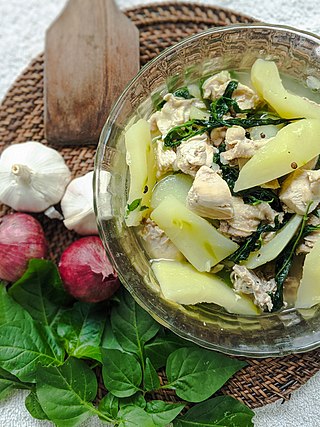
Tinola is a Filipino soup usually served as a main course with white rice. Traditionally, this dish is cooked with chicken or fish, wedges of papaya and/or chayote, and leaves of the siling labuyo chili pepper in broth flavored with ginger, onions and fish sauce.
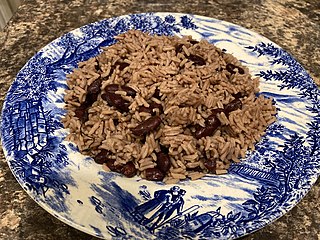
Rice and peas or peas and rice are traditional rice dishes within some Caribbean countries. The 'peas' used in this dish by some countries are traditionally pigeon peas otherwise called 'Gungo peas' in the Caribbean. Either kidney beans or pigeon peas are generally used for this dish. Rice and peas recipes throughout the Caribbean vary, with each country having their own way of making it and name of calling it, and are similar only by the two main ingredients which are the legumes (peas/beans) used and rice to form a mixture. The name "rice and peas" originally is used by Jamaicans to identify the dish, while other countries have different names for it.
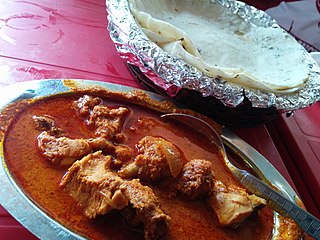
Chicken curry or curry/curriedchicken is a South Asian dish originating from India. It is common in the Indian subcontinent, Caribbean, Arabian Peninsula, Southeast Asia, Great Britain, and Japan. A typical curry from the Indian subcontinent consists of chicken stewed in an onion- and tomato-based sauce, flavoured with ginger, garlic, tomato puree, chilli peppers and a variety of spices, often including turmeric, cumin, coriander, cinnamon, and cardamom. Outside of South Asia, chicken curry is often made with a pre-made spice mixture known as curry powder.

Lupis is an Indonesian traditional sweet cake made of glutinous rice, banana leaves, coconut, and brown sugar sauce. Lupis is one of many glutinous rice desserts from Indonesia. Lupis are sometimes cylindrically shaped like Lontong. Lupis is usually eaten with thick palm sugar syrup and with shredded coconut toppings. Often eaten at breakfast or as a side dish during the evening, lupis is often sold at traditional marketplaces throughout Indonesia and is a popular food found nationwide, but especially in middle and eastern Java as well as West Sumatra. Lupis is one of the top desserts that tourists who visit Purwokerto in Java seek.

Coco bread is a Jamaican bread eaten on the island and in other areas of the Caribbean. The bread contains milk or coconut milk and is starchy and slightly sweet in taste.

Toto is a small coconut cake in Jamaican cuisine served as a snack or dessert. The cake is typically prepared with shredded coconut, brown sugar, flour, baking soda and powder, and coconut milk. It may also be added with some flavorings such as allspice, nutmeg, ginger, and salt.

Kaeng pa is a variety of Thai curry from the forested areas of Thailand. Unlike many other Thai curries, traditional kaeng pa usually contains no coconut milk, as coconuts are not naturally found in the rainforests in the northern part of the country. This quality makes it more suitable for people on low saturated fat diets. There are, however, variants that do include coconut.
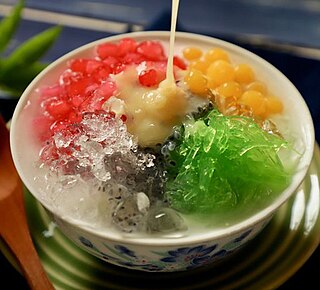
Es campur is an Indonesian cold and sweet dessert concoction of fruit cocktails, coconut, tapioca pearls, grass jellies, etc. served in shaved ice, syrup and condensed milk.
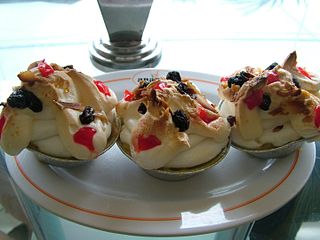
Klappertaart is a Dutch-influenced Indonesian cake originating from Manado, North Sulawesi. Klappertaart is Dutch for "coconut cake" or "coconut tart" and it is made from flour, sugar, milk, butter, and the flesh and juice of coconuts.
Alex Drum Hawkes (1927–1977) was an American botanist and cookbook author who lived in Coconut Grove, Florida & Kingston, Jamaica. Alex specialized in orchids, bromeliads, palm trees, fruits, vegetables, and nuts. Named the orchid genera Flickingeria, and Paraphalaenopsis and travelled the world extensively, particularly the Caribbean & Latin America during the 1940s - 1970s collecting plants and authentic regional recipes.

Pichi-pichi, also spelled pitsi-pitsi, is a Filipino dessert made from steamed cassava flour balls mixed with sugar and lye. It is also commonly flavored with pandan leaves. It is served rolled in freshly grated coconut, cheese, or latik before serving.

Pinaltok or Bilo-bilo is a Filipino dessert made of small glutinous balls in coconut milk and sugar. Then jackfruit, saba bananas, sweet potatoes, taro, and tapioca pearls or sago are added. Bilo-bilo's origin is in Luzon, which is the northern Philippines Island. There are different recipe versions depending on what region in the Philippines it is from. Some recipes call for young coconut meat and some call for adding pandan leaves. This is usually and traditionally eaten hot while others prefer eating them cold after refrigeration.
Stew peas is a Jamaican stew prepared using coconut milk, beans and salted meat. It is a common dish in Jamaica.

Piaparan, also known as pipaparan, piaran, or piarun, is a Filipino dish consisting of meat or seafood cooked in a coconut milk-based broth with grated coconut, garlic, onions, ginger, turmeric, young wild shallots (sakurab), labuyo chili, and various vegetables and spiced with palapa. It originates from the Maranao people of Lanao del Sur. Piaparan means "shredded coconut" in Maranao and is a type of ginataan.
Coconut burger, also known as sapal burger or niyog burger, is a Filipino veggie burger made with shredded coconut pulp (sapal), which are the by-products of traditional coconut milk extraction in Filipino cuisine. It is considered an ovo-vegetarian dish, but not vegan since it uses eggs as part of the ingredients.
References
- ↑ Jamaican Coconut Drops Cook Like a Jamaican
- ↑ "Jamaican Recipes: JAMAICAN COCONUT DROPS RECIPE". eatjamaican.com. Retrieved 1 May 2014.